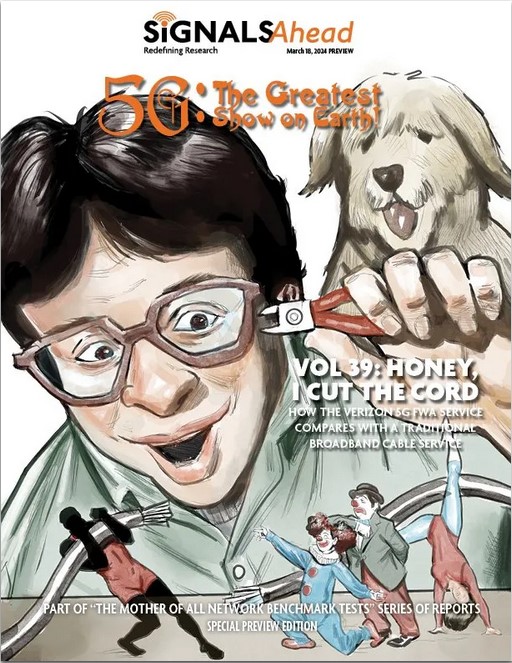5G、地上最大のショウ!:第39版 ミクロカット5G: THE GREATEST SHOW ON EARTH! Vol 39: Honey, I Cut the Cord (how the Verizon 5G FWA service compares with a traditional broadband cable service) Verizonの5G FWAサービスは従来の有線ブロードバンドサービスといかに異なるか? SRGは39回目の5Gベンチマーク調査を完了しました。今回は、Accuver Americas社およびSpi... もっと見る

サマリーVerizonの5G FWAサービスは従来の有線ブロードバンドサービスといかに異なるか?
SRGは39回目の5Gベンチマーク調査を完了しました。今回は、Accuver Americas社およびSpirent Communications社と共同で、ベライゾンの5G FWAサービスと、当社のMediacom Xtream 1Gbpsブロードバンドケーブルサービスとの比較について、独自のベンチマーク調査を実施しました。
レポートのハイライト: 感謝の意: この調査は、Accuver Americas社(XCAL-MおよびXCAP)およびSpirent Communications社(Umetrix Data)と共同で行った。SRGは、データ収集、本レポートで提供するすべての分析および解説に責任を負う。
コードを切った: 12月中旬、私たちはベライゾンの5Gホーム・インターネット・サービスに有料会員として加入し、同時にインターネット・アクセスの主要手段であったメディアコムのエクストリーム・サービスを廃止した。今のところMediacomの1Gbpsサービスは維持しているが、時折Verizonのサービスと比較してテストする程度であり、今後も主要なインターネットアクセス手段として使用する予定である。私たちのネットワークは、1つのアクセスポイントと2つのWi-Fiエクステンダー・ノードで構成されています。
メソドロジー: XCAL-M、Wireshark、Task Managerを組み合わせて、フルバッファのデータ転送と、Google Drive、Dropbox、電子メール、YouTube TV、ウェブブラウジングなど、より典型的なアプリケーションでのブロードバンド消費量を測定した。実際の帯域幅と利用可能な帯域幅の比較分析に加え、Umetrix Dataを使用して1Mbpsと5Mbpsの連続データストリームを生成し、待ち時間とパケットロスも評価しました。
300Mbpsで十分だ: ベライゾンのサービスはダウンリンクで300Mbpsに人為的に制限されているが、携帯電話では最大1Gbpsの通信が可能だ。1Gbpsのインターネット接続を持つことは、複数の広帯域アプリケーションを並行して実行しない限り、やりすぎだ。ヒント:ほとんどのアプリケーションは高帯域幅を発生させない。
20Mbpsでは十分ではない: ベライゾンのサービスは、アップリンクで20Mbpsに人為的に制限されている。アプリケーションによってはこれで十分だが、これだけの帯域幅を使うにはそれほど時間はかからない。我々は、ベライゾンが20Mbpsまでの速度を約束し続けるとしても、アップリンクで無制限の速度を提供するための説得力のある議論と思われるものを提供する。
レイテンシーはそれなりに良かった: 1つの重大な例外を除いて、ベライゾンの5G FWAサービスでは、ダウンリンク/アップリンクの片方向の遅延はそれなりに良好で、メディアコムのサービスよりもそれほど高くはなかった。他のアップリンク・バックグラウンド・トラフィックが存在する場合のアップリンク遅延は懸念材料である。
Wi-Fiのせいだ: ベライゾンのFWAサービスで発生した問題は、ネットワークのWi-Fi部分に起因している。問題点には、干渉の多さ(修正したと思っている)と、デバイスの愚かさ、つまりセルラーが存在するのに使えないWi-Fi信号でキャンプしたり、5GHzがすぐに利用できるのに2.4GHzを使ったりするデバイスが含まれる。これらの後の問題は、デバイスの責任である。前述の、他のバックグラウンド・トラフィックとのアップリンク遅延の問題は、(5Gが家庭用インターネット・サービスを提供する能力とは無関係に)対処すべき重大な問題であることに変わりはない。
SummaryHow the Verizon 5G FWA service compares with a traditional broadband cable service
SRG just completed its 39th 5G benchmark study. For this endeavor we collaborated with Accuver Americas and Spirent Communications to conduct an independent benchmark study of the Verizon 5G FWA service and how it compares with our Mediacom Xtream 1 Gbps broadband cable service. Highlights of the Report include the following: Our Thanks. We did this study in collaboration with Accuver Americas (XCAL-M and XCAP) and Spirent Communications (Umetrix Data). SRG is responsible for the data collection and all analysis and commentary provided in this report. We Cut the Cord. In mid-December we signed up for the Verizon 5G home Internet service as paying subscribers and simultaneously removed our Mediacom Xtream service as the primary means of Internet access,. We have so far retained the Mediacom 1 Gbps service, but only to occasionally test it against our Verizon service, which we will continue to use as our primary means of Internet access. Our network consists of one access point and two Wi-Fi extender nodes. Our Methodology. We used a combination of XCAL-M, Wireshark, and Task Manager to measure our broadband consumption with full buffer data transfers and with more typical applications, such as Google Drive, Dropbox, email, YouTube TV, and web browsing. In addition to analyzing actual bandwidth versus available bandwidth, we also evaluated latency and packet loss, using Umetrix Data to generate continuous 1 Mbps and 5 Mbps data streams. 300 Mbps is Enough. The Verizon service is artificially limited to 300 Mbps in the downlink – we can get up to 1 Gbps over cellular – but it is sufficient for most applications, most of the time. Having a 1 Gbps Internet connection is overkill unless there are multiple high bandwidth applications running in parallel. Hint, most applications do not generate high bandwidth. 20 Mbps isn’t enough. The Verizon service is artificially limited to 20 Mbps in the uplink. For some applications, it is sufficient but it doesn’t take much to use this much bandwidth. We provide what we think is a convincing argument for Verizon to delver unlimited speeds in the uplink, even if it continues to promise speeds up to 20 Mbps. Latency was reasonably good. With one critical exception, the one-way downlink / uplink latency was reasonably good with the Verizon 5G FWA service and not that much higher than our Mediacom service. Uplink latency in the presence of other uplink background traffic is a cause for concern. Blame it on the Wi-Fi. We can attribute the issues we’ve had with the Verizon FWA service to the Wi-Fi portion of the network. Issues include high interference – something we think we’ve fixed – and device stupidity, or a device camping on an unusable Wi-Fi signal when cellular is present or using 2.4 GHz when 5 GHz is readily available. These later issues are the fault of the device. The aforementioned issue with uplink latency with other background traffic remains a critical issue that needs to be addressed (unrelated to the ability of 5G to provide a home Internet service).
ご注文は、お電話またはWEBから承ります。お見積もりの作成もお気軽にご相談ください。本レポートと同分野(有線・ブロードバンド・IP)の最新刊レポートSignals Research Group社の5G The Greatest Show on Earth! シリーズ分野での最新刊レポート
本レポートと同じKEY WORD()の最新刊レポート
よくあるご質問Signals Research Group社はどのような調査会社ですか?シグナルズリサーチグループ社(Signals Research Group)は、無線通信市場の調査とコンサルティングを行っている米国の調査会社です。「世界市場での存在感」「技術中心」「実践的なアプロー... もっと見る 調査レポートの納品までの日数はどの程度ですか?在庫のあるものは速納となりますが、平均的には 3-4日と見て下さい。
注文の手続きはどのようになっていますか?1)お客様からの御問い合わせをいただきます。
お支払方法の方法はどのようになっていますか?納品と同時にデータリソース社よりお客様へ請求書(必要に応じて納品書も)を発送いたします。
データリソース社はどのような会社ですか?当社は、世界各国の主要調査会社・レポート出版社と提携し、世界各国の市場調査レポートや技術動向レポートなどを日本国内の企業・公官庁及び教育研究機関に提供しております。
|
|



